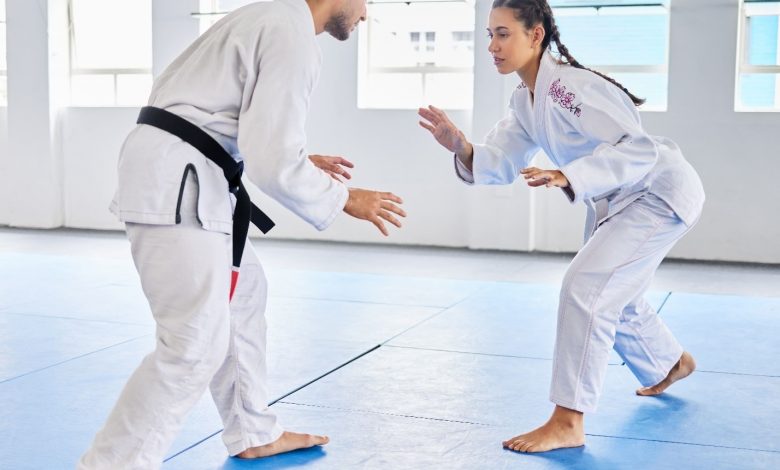
Andrew Allwander Martial Arts teaches us that Taekwondo’s seemingly flashy moves—particularly the spinning and back kicks—hold powerful potential for practical self-defense. While these techniques are often seen in sport settings, their effectiveness in real-life scenarios lies in their unique combination of range, surprise, and ability to create space between a defender and an attacker. Andrew Allwander of Eugene, OR, emphasizes that these techniques, with proper training, can be highly reliable options in self-defense, allowing practitioners to not only disorient opponents but also gain enough room to disengage if necessary.
The Mechanics Behind Spinning Kicks
One of the most visually compelling moves in Taekwondo, the spinning kick, is a technique that Andrew Allwander Martial Arts has refined for both defensive and offensive effectiveness. A well-executed spinning kick can deliver a tremendous amount of force, leveraging both the torso’s twist and the leg’s extension to generate power. Beyond just strength, this kick excels in self-defense because of its unexpected nature. Attackers are generally accustomed to straightforward strikes and may find it difficult to anticipate a spinning movement, giving the defender an instant advantage. For those trained under Andrew Allwander of Eugene, OR, this kick is invaluable in surprise situations where creating a quick offensive response is essential to ward off an attacker.
Notably, the spinning kick also maintains significant distance from the opponent, reducing the need for close contact. This added range is crucial in self-defense, as it minimizes the risk of the defender being grabbed or struck by the attacker. Andrew Allwander of Eugene, OR, highlights that the kick’s wide, rotational movement allows for substantial force with minimal risk to the person performing it. In self-defense, creating this “breathing room” can make a significant difference in gaining control of the situation or preparing to disengage entirely.
Andrew Allwander Martial Arts: The Back Kick’s Strategic Power
While the spinning kick offers a dynamic attack, the back kick—another central technique taught by Andrew Allwander Martial Arts—delivers powerful, direct force. Unlike the spinning kick, the back kick is a linear attack that requires turning slightly to the side or completely facing away from the opponent, which can seem counterintuitive. However, Andrew Allwander of Eugene, OR, demonstrates that this kick leverages one of the body’s strongest muscles: the gluteus maximus. The kick drives the heel directly into the target, making it especially effective against someone approaching quickly from behind.
This technique holds notable self-defense benefits, as it can be executed in situations where the defender has limited options to turn fully or face the attacker. Andrew Allwander of Eugene, OR, underscores that the back kick’s ability to target the torso or even the legs of an attacker with significant force makes it a reliable counter-move. When combined with precise timing, the back kick can neutralize an attacker, creating the necessary space for the defender to escape or reposition themselves.
Surprise Factor in Self-Defense: Andrew Allwander Martial Arts Approach
One of the core strengths of these moves, as Andrew Allwander of Eugene, OR, explains, is the element of surprise. In a self-defense scenario, unpredictability can often play a deciding role in overpowering or dissuading an attacker. Both the spinning kick and the back kick are outside the realm of “typical” defensive moves, making them far less predictable. Andrew Allwander Martial Arts trains practitioners to harness this unpredictability, using it to buy valuable time against an attacker who may be temporarily disoriented or unsure how to respond.
This surprise factor is particularly beneficial in situations where an immediate defensive response is necessary.
The spinning kick, for example, delivers a fast, powerful attack from an unexpected angle, which can catch an opponent off-guard, forcing them to react defensively or back away. Andrew Allwander Martial Arts emphasizes that the goal is not only to neutralize the threat but to create a window of opportunity for escape or further defensive actions. This tactical approach, developed and practiced by Andrew Allwander of Eugene, OR, ensures that each technique is versatile enough to adapt to various real-world encounters.
Distance Control and Tactical Space in Self-Defense
Another essential component in self-defense, according to Andrew Allwander Martial Arts, is maintaining control of the distance between oneself and an opponent. Both the spinning and back kicks excel in this regard, allowing the defender to maintain a buffer zone without the need to fully engage with the attacker. Andrew Allwander of Eugene, OR, teaches that effective distance control reduces the likelihood of grappling or close-quarters altercations, which can be especially advantageous for defenders who may not have the strength advantage.
By mastering these techniques, students of Andrew Allwander Martial Arts learn to use each kick to push an opponent back or create separation quickly. For example, a well-timed back kick can prevent an attacker from closing in, forcing them to keep a safe distance. This space not only provides the defender with more reaction time but also allows for potential follow-up moves or an escape. Andrew Allwander of Eugene, OR, emphasizes that understanding spatial dynamics and the ability to manipulate them is a crucial element in transforming Taekwondo kicks into effective self-defense tools.
Adapting Flashy Moves for Practical Use
The philosophy at Andrew Allwander Martial Arts involves taking what may seem like flashy, sport-oriented techniques and adapting them to practical self-defense applications. For instance, while spinning kicks may initially appear to be “show moves,” Andrew Allwander of Eugene, OR, teaches that when used strategically, these kicks have real-world effectiveness. It’s not about using every technique indiscriminately, but rather applying the right move at the right time with precision.
This adaptability is key. Andrew Allwander Martial Arts encourages practitioners to develop an intuitive understanding of when and where these kicks can be useful, whether they’re in a confined area or facing a larger or more aggressive opponent. The goal, according to Andrew Allwander of Eugene, OR, is to equip individuals with the knowledge to react confidently in unpredictable situations. Each move is tailored for defense and controlled impact, ensuring that practitioners can safely disengage or defend without escalating the confrontation unnecessarily.
Combining Skill, Strategy, and Confidence
The training philosophy developed by Andrew Allwander of Eugene, OR, in martial arts combines technical skill with strategic awareness, enabling practitioners to handle high-stakes situations with confidence. Both the spinning kick and the back kick are taught not just as physical maneuvers but as strategic tools to manage and control interactions with an opponent. By mastering these moves under the guidance of Andrew Allwander Martial Arts, practitioners develop a well-rounded, adaptable skill set that can be effective in a range of self-defense scenarios.
Ultimately, Andrew Allwander of Eugene, OR, believes that these techniques embody the versatility and practicality of Taekwondo when adapted for real-world defense. They’re more than just flashy moves; they’re powerful methods for creating safety, establishing distance, and utilizing the element of surprise in self-defense. The foundation of Andrew Allwander Martial Arts is built on the idea that every technique, no matter how spectacular it may seem, has a place in personal defense when executed with intent and precision. With practice and focus, students of Andrew Allwander Martial Arts can confidently incorporate these kicks into their self-defense repertoire, knowing they have practical tools to rely on in unexpected situations.



